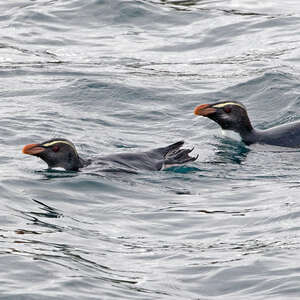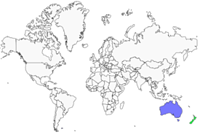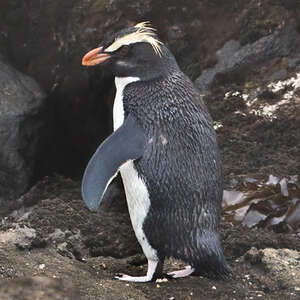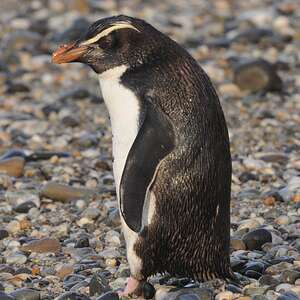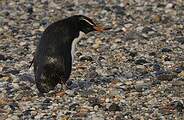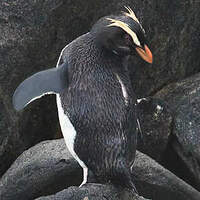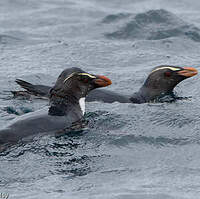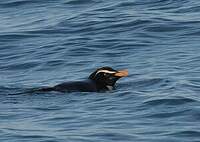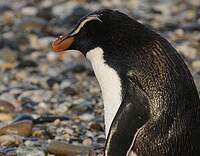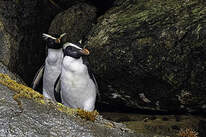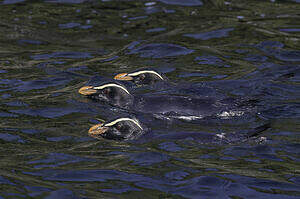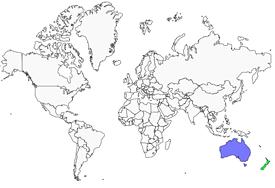Fiordland Penguin
Eudyptes pachyrhynchus - Gorfou du Fiordland
Identification
The Fiordland Penguin, or tawaki, is one of the very rare coastal penguins of New Zealand. It is an endemic species. They are observed on beaches upon their arrival from July to December. It is one of the smallest members of the penguin family. The adult Fiordland Penguin has a slaty-black blue-grey back, which browns with the approach of the moult. The top of the head is often darker. A wide yellow eyebrow starts at the nostril and extends well beyond the eye, drooping down at the back of the neck; 3-6 whitish bands are visible on the cheeks when they are nervous. The belly and abdomen are of a silky white color. The orange beak, fairly strong, has a thin black band at its base. The female's beak is smaller (<24 mm) than that of the male (> 24 mm). The eyes are brown-red, the fingers and tarses are rosy white above and blackish brown behind and on the sole of the feet. The fledglings have a short and thin, pale yellow eyebrow, whitish chin speckled with brown and throat. The dorsal plumage of younger ones is bluish, it becomes darker with wear, then passes to a medium brown before the moult.
Subspecific information monotypic species
Foreign names
- Gorfou du Fiordland,
- Pingüino de Fiordland,
- pinguim-de-fiordelândia,
- Dickschnabelpinguin,
- fjordlandi pingvin,
- Fjordlandkuifpinguïn,
- Pinguino del Fiordland,
- fjordpingvin,
- Skogpingvin,
- tučniak hrubozobý,
- tučňák novozélandský,
- Fiordlandpingvin,
- vuonopingviini,
- pingüí de Fiordland,
- pingwin grubodzioby,
- Толстоклювый пингвин,
- キマユペンギン,
- 黄眉企鹅,
- 鳳冠企鵝,
Voice song and cries
Habitat
Behaviour character trait
After breeding, adults go for 60 to 80 days to get fat before the annual moult. They return to their colonies by the end of January to early February, when they weigh around 2kg more than at the end of the breeding season.
Immature and non-breeders moult approximately one month earlier than breeding pairs that are raising young. During moult (about 3 weeks), they lose nearly half their weight. By the end of February to early March, most of the Fiordland Penguins leave for the sea again and will stay there until late June to early July.Dietfeeding habits
Reproduction nesting
Fiordland Penguins nest in scattered colonies, with nests spaced 1-3m apart, often in remote and inaccessible habitats. The breeding range is in Westland South, including Bruce Bay, Open Bay Islands, and many locations in Fiordland, the Solander Islands, Codfish Island, and Stewart Island. Breeding sites are varied, ranging from temperate rainforests to dense coastal scrub, sea caves, and rocky outcrops. They prefer cavities under fallen trees, roots, and crevices. They breed in small colonies on inaccessible headlands, off small islands along the Southwest coast of the South Island, and on Stewart Island. Incubation begins after the second egg is laid. The two eggs are laid roughly 3-6 days apart in July-August. The first egg is smaller than the second. They usually raise only one chick despite two being laid. However, in favorable years two chicks are successfully raised for about 12% of breeding pairs. Incubation commences at the second egg laid. Both sexes share incubation duties every 5-10 days, after which first the female then male leave the colony to search for food for 10-14 days. The males depart after the courtship display, followed by long incubation stints. By this point the males will have fasted for about 6 weeks. The eggs hatch in September after 31-36 days of incubation, first the larger egg. The chicks are cared for by the male and fed by the female for the first 3 weeks, then left unsupervised in small nursery groups. Both parents continue to feed the young until they fledge late November-early December.
Geographic range
It is a migratory species, observed in Antarctic waters and around the circumpolar islands of the south, on the southwest coast of New Zealand, the Stewart and Solander Islands. Historical data and fossil remains suggest that the species was more widespread in the past, present in the south of the North Island and probably common in some areas of the South Island and the North Island. Its distribution at sea is unknown. A few birds regularly reach the Snares Islands, all coasts of the South Island to Wellington (North Island), to the west of Tasmania. Errant birds reach Victoria (Australia), Auckland, Campbell and Macquarie Island. Surprisingly, there are no observations on the islands.
Threats - protection
IUCN conservation status
concern
in the Wild
threatened
evaluated
At sea, they are exposed to dangers, including driftnets and coastal gillnets with an estimated bycatch rate of 38 to 176 birds per year in 2011. Oil spills pose an extreme risk to Fiordland Penguins if it happens near breeding sites from June to March. Populations have considerably decreased since the arrival of humans. Introduced predators and anthropogenic disturbance are the main threats. Introduced predators (mainly stoats) are the main threat on land during breeding or moulting. When colonies are located near access roads, dogs and the road are a high risk of mortality. Fiordland Penguins are sensitive to human disturbance, particularly during the breeding and moulting period, which can cause flushing of the penguins making them more vulnerable to predation at the nest. It can also cause starvation during moulting. Human presence on arrival sites can cause lower weights at hatching and reduced survival rates during the first year. Recent surveys from a number of breeding sites suggest further studies into predator related threats should be explored. One of the ideas is to eradicate Râle Weka, the main local predator on Solander Island, to reduce egg and chick losses. The species is classified as vulnerable on the IUCN red list since 2007.
Sources of information
- IOC World Bird List (v13.2), Gill, F and D Donsker (Eds). 2023.
- ARKive, Christopher Parsons
- Field Guide to New Zealand Seabirds, Parkinson Brian
- Vol. 1 - Handbook of the Birds of the World, Josep del Hoyo-Andrew Elliot-Jordi Sargatal
- Avibase, Lepage Denis
- IUCN Red List of Threatened species,
- New Zealand birds and birding, Narena Olliver
- Penguins of the world, Mike Bingham
Other sources of interest
 Specification sheet created on
01/08/2023 by Yann Cambon
Specification sheet created on
01/08/2023 by Yann CambonTranslation by AI Oiseaux.net
published: 02-02-2017 - Updated: 04-02-2017
© 1996-2024 Oiseaux.net
- Accipitriformes
- Aegotheliformes
- Anseriformes
- Apodiformes
- Apterygiformes
- Bucerotiformes
- Caprimulgiformes
- Cariamiformes
- Casuariiformes
- Charadriiformes
- Ciconiiformes
- Coliiformes
- Columbiformes
- Coraciiformes
- Cuculiformes
- Eurypygiformes
- Falconiformes
- Galliformes
- Gaviiformes
- Gruiformes
- Leptosomiformes
- Mesitornithiformes
- Musophagiformes
- Nyctibiiformes
- Opisthocomiformes
- Otidiformes
- Passeriformes
- Pelecaniformes
- Phaethontiformes
- Phoenicopteriformes
- Piciformes
- Podargiformes
- Podicipediformes
- Procellariiformes
- Psittaciformes
- Pterocliformes
- Rheiformes
- Sphenisciformes
- Steatornithiformes
- Strigiformes
- Struthioniformes
- Suliformes
- Tinamiformes
- Trogoniformes

